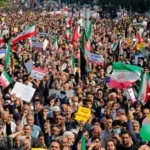By pushing the narrative about protests benefiting external enemies, the Iranian regime is hoping to appeal to nationalist sentiments, while also justifying its violent crackdown. Without genuine reforms, Iran’s leaders might be engaging in a temporary firefighting exercise.
Updated: November 22, 2022 1:11:27 pm

The nationwide protests in Iran triggered by the death of 22-year-old Mahsa Amini in the custody of Tehran’s Morality Police have sustained for over two months. Following the terrorist shooting in Shah-e-Cheragh shrine in Shiraz in October — for which ISIS claimed responsibility — the commander-in-chief of the Islamic Revolutionary Guard Corps, Major General Hossein Salami, blamed the US, the UK, Israel and Saudi Arabia. He then advised the protesting youth: “Return to the nation, don’t play into the hands of enemies.” Bot farms and Persian-language media have amplified the regime-change narrative. But by externalising the driving force of protests, Iran’s ruling elites cannot wish away the entrenched political, sociocultural conditions that have regularly forced the country’s youth to take to the streets.
The Islamic Republic is essentially a hybrid political system, with the “velayat-e-faqih” (guardianship of jurist(s)) embodying divine sovereignty, while the institutions of the president and parliament represent popular sovereignty. Since the early 1990s, Iranian political culture has been defined by contestation between the conservatives, whose ideological totalitarianism limits political participation for the people to mass mobilisation, and the reformists, who have argued for a freer public sphere and popularised the concepts of civil society and rule of law. However, unelected clerical-dominated institutions asserted control by creating a narrative about a cultural invasion by a hostile West.
In 1999, when conservative-controlled courts forced the shutdown of an influential reformist daily Salam, student protests broke out across the country. They lasted six days until the IRGC-affiliated Basij militia and police raided Tehran University dormitories in a violent crackdown. Ten years later, tens of thousands of young Iranians thronged the streets against what they saw as the rigging of elections in favour of hardline president Mahmoud Ahmadinejad. Called the “Green Movement”, the slogans of the protest — “Down with the dictator”, “Neither Gaza, nor Lebanon”, “my life is sacrificed for Iran” — underscored the rise of an avowedly nationalist, post-ideological, and liberal political consciousness among the country’s youth. Supreme Leader Ayatollah Khamenei had denounced the movement as “fitna”, an internal strife orchestrated by external enemies.
While the Islamic Republic has successfully weathered spontaneous popular protests, it has found it harder to deal with what sociologist Asef Bayat has described as “social non-movements”. These embody the shared practices of a large number of ordinary people, whose fragmented — but similar — actions trigger social change. These practices are rarely guided by ideology or recognisable leadership and organisations. This “non-movement” has thrived in Iran in the last decade. A proliferation of cafes as alternative cultural spaces across major Iranian cities, millions of young women testing the boundaries of state-enforced “Islamic” dress code and the estimated 45 million Instagram users, blurring the line between virtual and reality, attest to the phenomenon. During a trip to Iran in January 2020, I visited a café in Tehran which displayed a portrait of the iconoclast Iranian feminist Forough Farrokhzad next to one of Marilyn Monroe. At another cafe in Shiraz, a mural of Iranian maestro Mohammad-Reza Shajarian shared space with a poster of filmmaker Alfred Hitchcock.
In 2019, the Tehran police shut down over 500 hundred cafes and restaurants for failing to observe “Islamic principles”. Last year’s presidential election, in which President Ebrahim Raisi faced no serious moderate or reformist rival thanks to the Guardian Council’s heavy vetting of candidates, was met with apathy from the majority of youth. The lack of economic prospects and an unresponsive political system may have contributed to militant tendencies among the youth. By pushing the narrative about protests benefiting external enemies, the regime is hoping to appeal to nationalist sentiments, while also justifying its violent crackdown. The protests may eventually die down, but without genuine reforms, Iran’s leaders might well be engaging in a temporary firefighting exercise.

